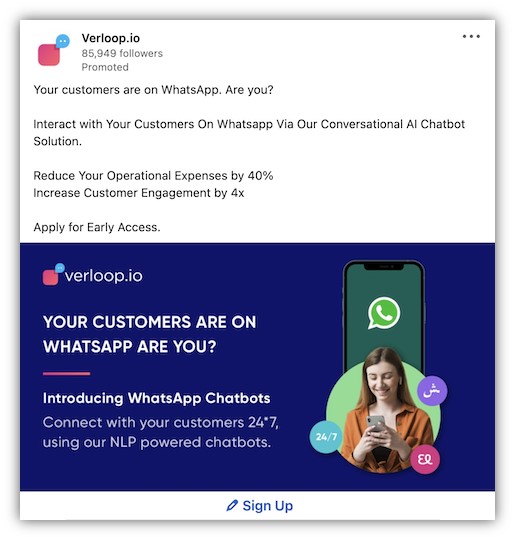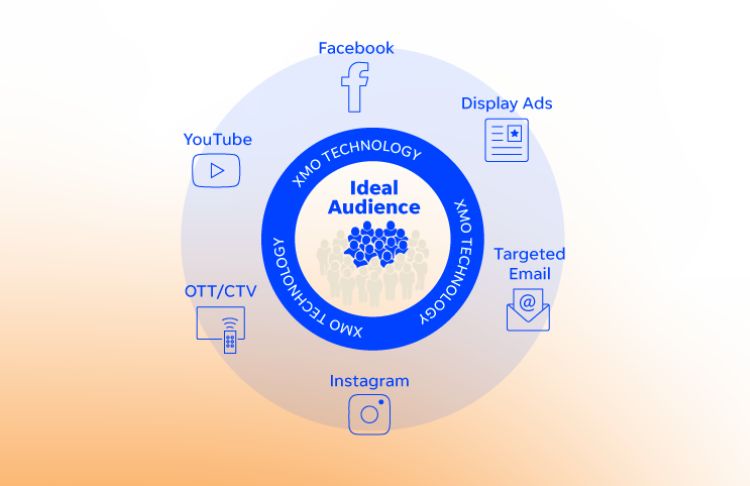“The most important skill for ad copywriting isn’t writing. It’s empathy. You need to fully feel what your prospective customer is feeling. Prove you understand them. Then they’ll listen.”
Those are wise words from Scott Lieberman, the Founder of Touchdown Money, who has been writing copy for over a decade. But what does this advice look like in practice? Let’s answer that question by way of over a dozen real-life examples of ad copy. We’ll cover what each of these 12 ad copy examples does well and, more importantly, how you can apply their positives to your own copy.
Table of contents
- Facebook ad copy examples
- LinkedIn ad copy examples
- Google search ad copy examples
- TikTok ad copy examples
- The five pillars of good ad copy
Great examples of ad copy for Facebook
Over 10 million businesses have taken advantage of Facebook advertising in recent years—with the majority of those businesses being small to medium in size. The world’s most popular social media platform is a great way to get your company, products, and services in front of your ideal customers. As such, there are many well-done Facebook ad examples you can learn from, including the following three.
1. The Maher Drury Team
This copy uses: Descriptive language
This Maher Drury ad is a good example of the power of descriptive language. It leads with two of the most important qualifiers house hunters have—home style and location. This immediately grabs the attention of those most likely to become interested buyers.
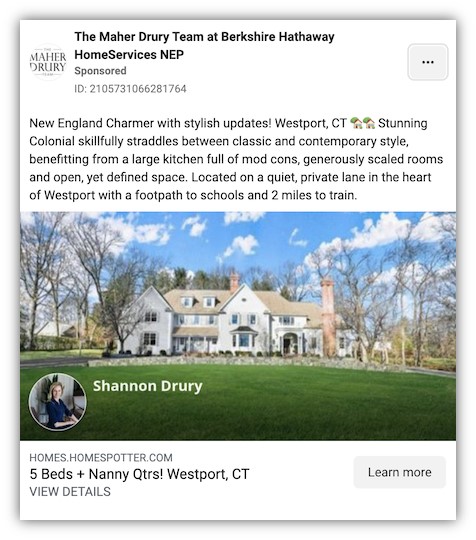
Using vivid descriptors, it then paints a picture of the property. Notice the focus on the most desirable features buyers look for like the mix of classic and contemporary styles, large kitchens, and so on.
This real estate Facebook ad then concludes by touching on the target audience’s deep-rooted desire for peace and quiet, while also directing their attention back to one of their top qualifiers—location.
🗝️ Takeaways: Adjectives and adverbs alone aren’t what makes ad copy persuasive. Identify the top needs, desires, or paint points of your audience and describe those. Do so in order of importance to your audience and keep the descriptions simple.
2. REASON CLOTHING
This copy uses: Time pressure and ease of action
This Facebook ad copy from REASON CLOTHING is only 14 words long. At first glance, it’s unremarkable but its directness is strategic.
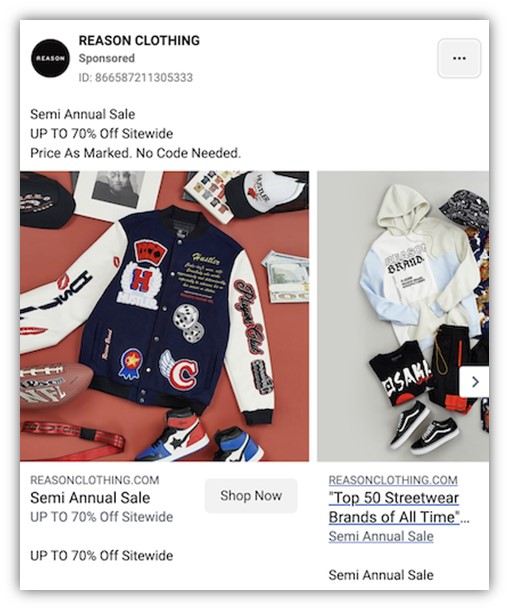
Of course, the discount is a big incentive in itself. But, beyond that, the use of “semi-annual” and “sale” create time pressure. It makes clear to potential shoppers that they’ll miss out if they don’t act right away, increasing the chances that they’ll at least browse REASON’s site.
Additionally, the copy highlights in three ways that shopping with REASON is a frictionless experience. It mentioned that the sale is sitewide, that prices are as marked, and that there’s no discount code needed. It sets the expectation that shoppers can find deeply-discounted, limited-time deals easily. This eliminates any confusion about what’s on sale, how much items cost, or whether the proper discount was applied.
🗝️ Takeaways: While you should never create a false sense of urgency, if there’s a real reason for your audience to act quickly, mention it. Additionally, when asking your audience to take the next step, let them know what to expect. Specifically, proactively address any questions or concerns they may have about how difficult or time-consuming that next step will be.
3. GraySquare Solar
This copy uses: Financial incentives and core values
This GraySquare Solar ad emphasizes a top desire of the company’s target market—saving money. Not only does the copy mention “free” and a 30% tax credit, but it also uses a persuasion tactic known as anchoring.
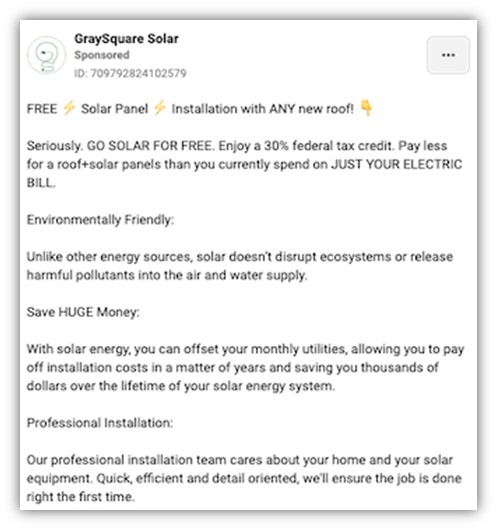
In a monetary context, anchoring involves introducing a high cost (or anchor) in the minds of your audience first. That way, the price you negotiate down to or agree upon in the end seems like a steal in comparison. This technique is used in several ways. For example, “This bundle is worth a total value of $299 but, for a limited time, we’re offering it to you for just $129.99.”
This solar panel advertisement doesn’t get into specific costs. Yet, it does prompt readers to think about their typical electric bill, which is probably a pain point of theirs. As a result, the surprising statement that they could pay less for a new roof and solar panels combined is an attention-grabber.
Additionally, the copy appeals to core values potential customers have such as environmental consciousness and professionalism.
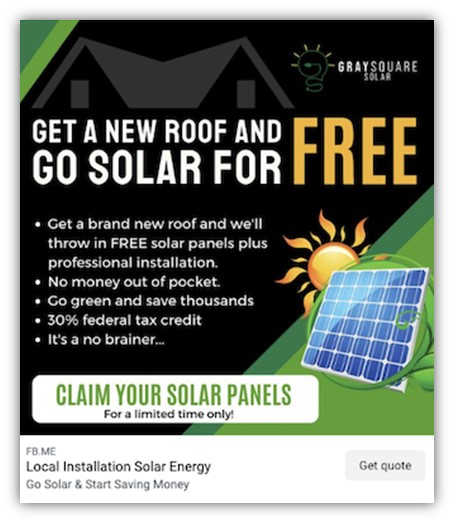
🗝️ Takeaways: When appropriate, use trigger words related to pricing. Plus, does your offer comes with a big price tag or could it require a big decision? Position it as a beneficial investment rather than an expense. This can include appealing to core values as you saw above.
The best ad copy examples from LinkedIn
LinkedIn’s advertising platform gives users access to as many as 65 million business decision-makers. This makes it an excellent way to generate high-quality leads and drive conversions. Let’s see the role copy plays in getting these outcomes.
4. Verloop.io
This copy uses: Conversational language, quantifiable benefits, and exclusivity
Can you spot the positives in Verloop.io’s ad for its artificial intelligence-powered chatbot? First, instead of talking at or about the target audience, the copy speaks to them using “you” and “your.” It also uses a question to spark engagement and prompt Verloop.io’s ideal customers—people who answer “no”—to keep reading.
Additionally, the copy doesn’t just stop at telling viewers what the AI chatbot can help them do. It mentions the benefits of AI chat, along with numbers to quantify just how valuable the chatbot is. Then, Verloop.io teases that viewers can enjoy those benefits before anyone else by signing up for early access.
🗝️ Takeaways: Speak to your target audience in a natural and engaging way. Be specific about the benefits of taking the action you’re recommending.
5. MasterClass
This copy uses: Concise language and trust-builders
Although this MasterClass ad for LinkedIn is short, it resulted in many course signups as evidenced by the comments. There are a couple of reasons it’s so effective. One, much like a hostage negotiator’s words would be, the copy is concise and firm. It spells out in very few words what viewers will get if they invest in this training, and leaves the ball in their court to decide the next step.

Additionally, it establishes the credibility of the information in two ways. It mentions Chris Voss by name, which captures the attention of people who are familiar with him. And it states what qualifies him to teach sales teams, which are ultimately teams full of negotiators.
🗝️ Takeaways: Of course, not all of your ads should be this short; some may warrant long-form copywriting. But make your point ASAP, highlight why your target audience should trust it, and say no more.
6. Udemy
This copy uses: Trust-builders and sneak peeks
Like the MasterClass ad above, this Udemy ad also uses trust-builders but a bit more forcefully. It references an observation that the target audience—people leaders—would most likely agree with, showing that Udemy keeps abreast of industry changes. It also namedrops a respected publication with an established people leader who shared her insights on the topic in Forbes.
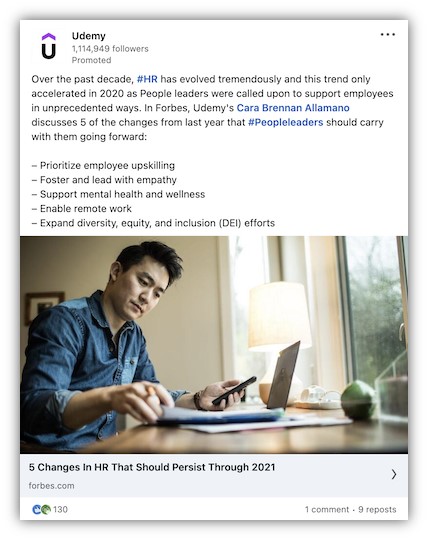
Beyond this, the ad copy included the five topics Brennan Allamano talked about. This transparency no doubt helped drive clicks from people interested in those topics who may not have otherwise stopped to read the article.
🗝️ Takeaways: Build trust with your audience either by establishing common ground, sharing fresh knowledge, or offering social proof. Also, set clear expectations for what people can expect if they follow through on your call to action.
Google ad copy examples worth learning from
Google search ads often cost a pretty penny to run (find out exactly how much via our 2023 search ad benchmark report). So, of course, advertisers work hard on their copy to ensure they get a return on their investment. Here are some examples of well-done copy for Google ads.
7. monday.com
This copy uses: Competitive comparison
Take a look at this Google search ad monday.com ran for the keyword “Trello alternatives.”
First, the title is an attention-grabber, prompting searchers to wonder why monday.com is better. The main ad copy explains.

It doesn’t just give general info about monday.com’s features and capabilities. It addresses the main reason a searcher would be looking for alternatives to Trello—lack of workflow flexibility.
🗝️ Takeaways: Highlight the features and capabilities that are top of mind for your ideal customers. Especially in cases you’re being compared with competitors. Or when your audience is seeking a solution to a problem that competitors don’t adequately address.
8. Social proof-infused ad copy: Pro Business Plans
This copy uses: Trust-builders
This ad from Pro Business Plans targets the keyword “business plan services Miami.” It’s heavy on language meant to inspire confidence in the company’s capabilities. The title alone makes two powerful points:
- The services are so consistently good that the company has been voted #1 for a decade.
- The services are so good that investors—the main people searchers are trying to impress—voted them #1.

The rest of the copy then drives those points home with other trust-builders that serve various purposes:
- “Business plans created by finance executives” points to the quality of the deliverables thanks to those executives’ expertise.
- “10K+ clients” highlights that many other businesses trust this company so searchers can too.
- “60+ industries” points to the company’s versatility and addresses searchers’ questions about whether or not Pro Business Plans is right for them.
- $4B+ raised” backs up the claim in the first sentence that these services help customers raise more.
🗝️ Takeaways: You don’t need to bombard your audience with every reason why they should trust you at every turn. But take opportunities to build your credibility when:
- You want people to take immediate action—especially the less familiar they are with your company.
- Your call to action involves significant effort or perceived risk.
- You make big brand promises and need to prove that you can deliver.
9. Emotional trigger-based ad copy: QuickBooks
This copy uses: Ease of use and trust-builders
Next is this QuickBooks ad that showed for the query “bookkeeping software for small business.” The copy acknowledges that bookkeeping is a stressful or, at the very least, tedious and time-consuming task for small business owners.

Hence the use of language like “easy bookkeeping solution,” “take bookkeeping tasks off your plate,” and “rely on your bookkeeper.”
At the same time, the copy addresses a top concern of small business owners—accuracy. By highlighting access to a certified bookkeeper, searchers may automatically be more trusting of QuickBooks’ solution.
🗝️ Takeaways: Prioritize your main selling points. If a specific pain point is top of mind for your audience, your first order of business is to show how your solution alleviates it. When appropriate, you can then address other closely-related pain points, desires, and needs.
Compelling TikTok ad copy examples
In 2022, TikTok’s net ad revenue was over $5 billion—with that number expected to double by 2024. Here are just a few of the thousands of TikTok ads brands have invested in, as well as some lessons from the copy.
10. Poshmark
This copy uses: Relatability and core values
Poshmark’s only goal for its “Save $$ with Poshmark” ad was to drive app installs. So, how did Poshmark get the video’s conversion rate (CVR) within the top 21% of the industry average?
First, the video immediately reels relevant viewers in with the line, “If you’re like me and want to spice up your wardrobe this year without breaking the bank, this one is for you.” It establishes common ground, prompting anyone who is interested in spicing up their look to keep listening.
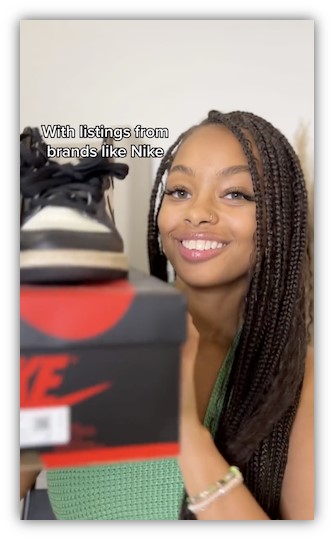
Additionally, the ad copy appeals to various core values throughout. For example, it mentions not “breaking the bank” and that Poshmark gives you the ability to shop hundreds of brands “at incredible prices.” Such phrases are likely to resonate with people who are looking to save money and, therefore, value balance and responsibility.
Likewise, mentions of “listings from brands like Nike (and even designer pieces” appeal to the desire for status. Plus, the video even mentions the sustainability aspect of Poshmark, which centers around secondhand clothing.
🗝️ Takeaways: When you can establish common ground with your audience rather than simply selling to them via a shoppable ad, do it. For example, if you use your own products, say so! Also, highlight how your brand or offer satisfies or aligns with the values of your ideal customers.
11. Playsee
This copy uses: Trigger words and familiarity
Last up, there are lessons to be learned from the copy in one of Playsee’s TikTok ads. The lead-in is, “There’s a brand new social media app that just came out and nobody even knows about it.” The trigger word “new” and reiterating that the app is still unknown gives viewers the exciting feeling that they could be the first to know about the next big thing.
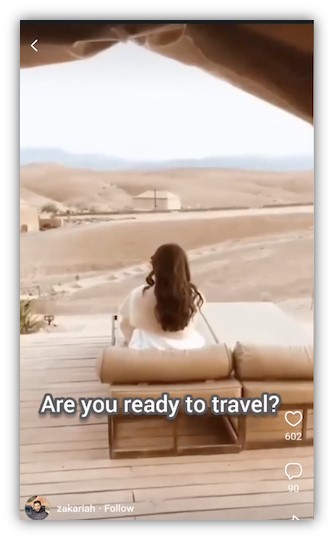
However, since the app is new, one main job of the copy is to help viewers understand what the app concept is. To do this, it uses the phrasing, “It’s kinda like TikTok and Snapchat had a baby.”
For those familiar with both, this clarifies what Playsee is before the rest of the video gets into deeper explanations and examples of how it works. It reduces fear—or disinterest in the unknown—that could otherwise prevent people from checking out the app.
🗝️ Takeaways: Use emotional words and phrases to spark curiosity, fear of missing out, and other feelings that can lead to action. Also, if you introduce a topic that could intimidate or confuse your audience, make connections to things they understand and feel comfortable with.
12. TikTok
This copy uses: Benefits-focused copy and a clear call-to-action
TikTok’s own ad copy for the Promote feature has been wildly successful, contributing to TikTok’s goals of driving traffic, increasing reach, and generating conversions. Both the click-through rate (CTR) and conversion metric for this ad were in the top 1% of the industry average. Why?
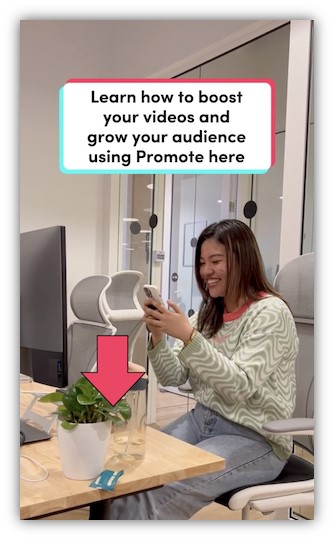
It’s totally benefits-focused. The first caption reads, “When you start seeing the benefits of using Promote for your business.” The next captions then add context on what those benefits are. Of course, they align with the top things potential Promote users want—more followers, more views, and more traffic to their business websites. The video then closes with a “learn more” CTA that encourages viewers to click on the ad by reiterating the value they’ll get from doing so.
🗝️ Takeaways: As mentioned before, be clear about what the next step is and the top benefits your audience can expect from engaging with you.
What makes good ad copy?
We’ve covered a lot of copywriting techniques thus far via the ad copy examples above. Now, let’s distill them into five guidelines you can refer back to as you tackle ad copywriting yourself.
1. Hyper-relevant messaging
What happens if your audience can’t immediately tell that your message is relevant or may be interesting to them? The chances of them taking a closer plummet.
So, speak to your audience, and not just by using “you” and “your.” Focus your message on key points that prove its relevance to the person viewing it. This is why it’s so crucial that you conduct in-depth audience research (and refresh that research periodically) to understand their pain points, objectives, and so on.
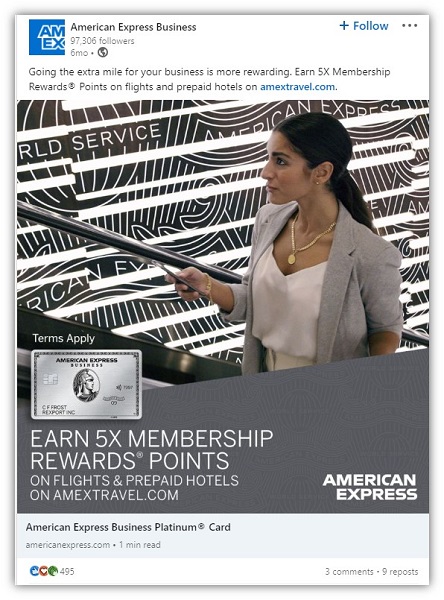
2. Carefully chosen language
Another aspect of developing hyper-relevant messaging is using language that’s familiar to your audience. But to use that language, you must first know it. That’s why it’s so important to do social listening, conduct user interviews, and review customer interactions such as website chat support transcripts.
However, striking a balance between speaking like your audience and staying authentic to your brand is important. Define your brand reputation and voice, and think about how your company’s core values influence those things. Then, lean into areas of overlap as far as your and your audience’s personalities, voices, and values.
Be careful about word choice as well. Remember that words can have similar meanings but different connotations (e.g. affordable vs. cheap) and that certain words trigger certain emotions (e.g. luxurious vs. expensive). Define what emotions you hope to trigger before you start writing so you can stick to the plan as you go.
3. Trust-builders
Benefits-focused copy is great. But it’s not as powerful as it could be when it’s not backed up with proof of:
- The credibility of your information, such as the mention of a subject matter expert who contributed the information or the research it was pulled from
- Your expertise, such as well-known brands you’ve gotten great results for or challenging problems solved
- Your ability to deliver the result you promise, including testimonials or results generated for past customers
While you can strategically incorporate trust-builders in all copy, they’re especially important when you don’t have strong pre-established relationships with your ad audience. Trust-builders are also important when you have an expensive offer (either monetarily or in terms of the risk or difficulty of implementation).
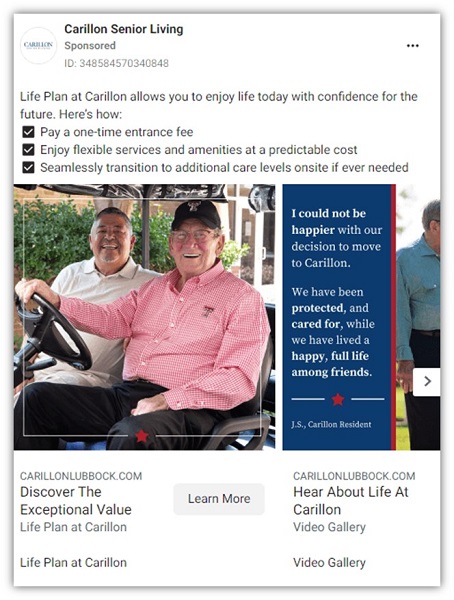
4. A direct, benefits-focused call-to-action
More often than not, it’s worthwhile to explicitly state what you’d like viewers to do based on the information shared in your ad. Whenever you have a direct call-to-action, be clear about the action item suggested (e.g. “download the free guide” or “sign up today”). Preferably also clarify what your audience can expect in return (e.g. “visit our website to get a free, instant quote).
Lastly, avoid using passive language like, “A confirmation email will be sent to you once your booking is complete.” Not only is it wordy but it doesn’t reiterate what you want viewers to do. Use active voice such as “Book now and receive a confirmation email right away!” instead.

5. Learnings from experimentation
Some ad copywriters swear by frameworks like Pain Agitate Solution (PAS) and Attention Interest Desire Action (AIDA). “Why experiment and risk losing conversions when you could use a technique or formula that’s already proven to be effective?” they say. While there’s some sound logic in that argument, there are also good reasons to take more creative approaches to ad copywriting.
The question isn’t necessarily “should you experiment?” but instead “when should you experiment?” Chelsea Cohen, Co-Founder of SoStocked and 7-figure Amazon seller, weighed in saying:
“Experimentation works best when you’re well into the selling game [and] have a stable base of loyal customers who might appreciate your new-found creativity. They may even be willing to offer feedback if you request a survey response to gauge your copywriting success.”
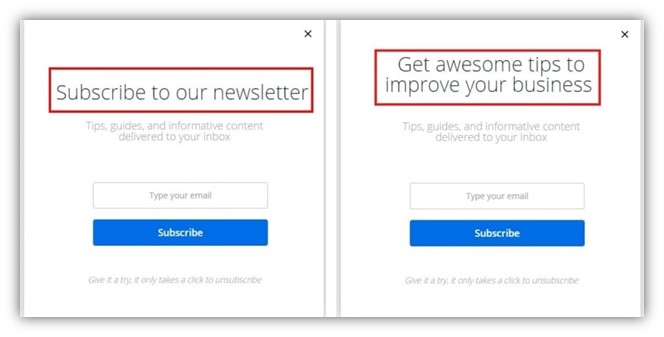
An example of a copy A/B test.
According to Cohen, experimenting too much can backfire, costing you immediate conversions and long-term relationships. Cohen continued: “It’s wise to implement tried and true copywriting best practices in the beginning. This will allow you to dip your toes into the market and reel in customers. These will keep your sales going while you strategize new copywriting approaches.”
This is an excellent way to reduce risk when testing different styles and variations of your ad copy. But, to be clear, the advice is not to build a solid customer base and then completely flip your messaging on its head. The results could be catastrophic if it doesn’t work.
Hence the reason Chelsea warned, “Even when you do include experimentation, don’t change all of your [ads] simultaneously. Consider selecting one or two you’d feel comfortable risking while you trial new messaging. Once you’ve evaluated their success (or failure), you can move on to a couple of others to test out different messaging.”
In other words, don’t be afraid to take inspiration from ad copy examples out in the wild and test to find the best approaches for your company. As long as you stick to the five best practices above, you can progress toward or even exceed your advertising goals.
Use these ad copy examples as inspiration
When you refer to ad copy examples like these, you can turn your advertising dreams into reality. Using ad copy examples to help inspire your own ads can cut down the time it takes to brainstorm your perfect ad. If you feel like you need extra help to work these ad copy examples into your own strategy, see how our solutions can help.
To recap, here are the five characteristics you’ll find in any good ad copy example:
- Hyper-relevant messaging
- Carefully chosen language
- Trust-builders
- A direct, benefits-focused CTA
- Learnings from experimentation
